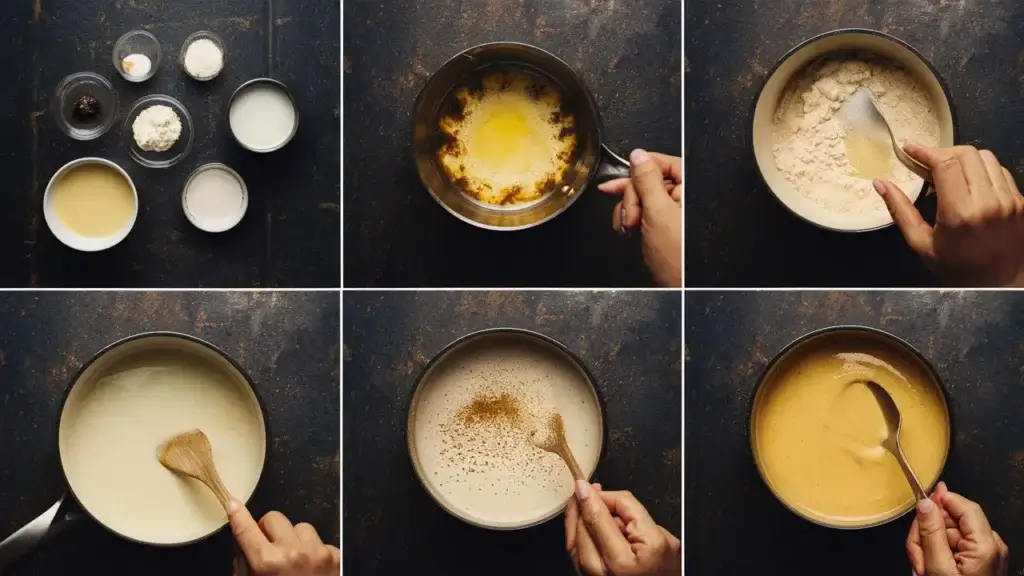Salsa Béchamel, commonly known as Béchamel sauce or white sauce, holds a crucial place in classical French cuisine. This creamy, smooth, and versatile sauce can elevate various dishes, ranging from lasagna to gratins. Additionally, it serves as the foundation for other popular sauces, such as Mornay and mustard sauce. In this comprehensive guide, you’ll explore every aspect of making Salsa Béchamel, ensuring you master this essential sauce with ease.
Introduction to Salsa Béchamel: The Essence of French Culinary Art
Salsa Béchamel, often referred to as Béchamel sauce, carries a rich history and importance in French cooking. Although it consists of a simple combination of butter, flour, and milk, this white sauce plays a significant role in countless recipes. Therefore, understanding its significance and mastering its preparation will greatly enhance your culinary repertoire.
The Origins and History of Salsa Béchamel
Béchamel sauce originated in the 17th century, taking its name from Louis de Béchameil, a steward to King Louis XIV. While one of the king’s chefs likely developed the sauce, it became associated with Béchameil due to his prestigious position. Initially, chefs made the sauce with cream, but it evolved over time into the milk-based version we know today. By understanding the history of Salsa Béchamel, you can enrich your appreciation of this sauce and its vital role in classical French cuisine.
Ingredients for Salsa Béchamel: Building Blocks of Flavor
Essential Ingredients
The ingredients for Salsa Béchamel are simple, yet each one plays a crucial role in the final flavor and texture of the sauce. Here’s a breakdown of the essential components:
- Butter: The foundation of any good Béchamel sauce, butter adds richness and a subtle nutty flavor when cooked. It is important to use unsalted butter to control the saltiness of the sauce.
- Flour: Combined with butter to create a roux, flour thickens the sauce. Fresh all-purpose flour works best, as stale flour can impart an off-flavor.
- Milk: The primary liquid that transforms the roux into a smooth sauce. Whole milk is preferred for its richness, but 2% milk works as a lighter alternative.
- Salt: Enhances the sauce’s flavors. Begin with a pinch and adjust as needed.
- Nutmeg: A classic seasoning in Salsa Béchamel, nutmeg adds a warm, subtle spice that complements the sauce’s richness.
Optional Additions
- Pepper: Freshly ground white pepper is traditional since it doesn’t speckle the sauce. However, black pepper can be used if you prefer.
- Bay Leaf: Adds an aromatic layer to the sauce, and it should typically be removed before serving.
- Onion or Shallots: Infuse the milk with a delicate flavor by steeping a halved onion or a few shallots in the milk before adding it to the roux.
Step-by-Step Guide to Making Salsa Béchamel

Step 1: Preparing the Roux
The roux forms the foundation of Salsa Béchamel. This simple combination of equal parts butter and flour is cooked together to eliminate the raw taste of the flour and create the base of the sauce.
- Melt the Butter: In a medium-sized saucepan, melt 2 tablespoons of unsalted butter over medium heat. Be careful not to let the butter brown, as this could affect the color and flavor of your Béchamel sauce.
- Add the Flour: Once the butter has fully melted, add 2 tablespoons of all-purpose flour. Stir the flour into the butter using a wooden spoon or whisk. Cook the roux for about 2-3 minutes, stirring constantly. The mixture should remain pale and avoid browning. The goal is to cook out the raw taste of the flour without coloring the roux.
- Monitor the Consistency: As the flour and butter combine, you’ll notice the mixture thickening. It should have a smooth, paste-like consistency. This step is crucial for determining the texture of your final sauce.
Step 2: Adding the Milk
The next step involves adding milk to the roux, transforming it into a smooth and creamy sauce. Gradually adding the milk helps avoid lumps.
- Warm the Milk: Before adding it to the roux, warm 1 cup of milk (preferably whole milk) in a separate saucepan or in the microwave. Warming the milk helps it incorporate more smoothly into the roux, reducing the risk of lumps.
- Incorporate the Milk: Slowly pour the warm milk into the roux, whisking constantly. Start with just a small amount of milk to loosen the roux, then gradually add the rest. Whisk vigorously to ensure a smooth mixture.
- Simmer the Sauce: Once all the milk has been incorporated, bring the sauce to a gentle simmer. Continue whisking as the sauce thickens. This process should take about 5-7 minutes. If you prefer a thinner sauce, add a little more milk. On the other hand, for a thicker sauce, allow it to simmer longer.
Step 3: Seasoning the Salsa Béchamel
Seasoning is key to making a flavorful Salsa Béchamel. The right balance of salt, pepper, and nutmeg can transform a basic sauce into something extraordinary.
- Add Salt and Pepper: Season the sauce with a pinch of salt and freshly ground white pepper. Taste and adjust as needed.
- Grate Nutmeg: Freshly grated nutmeg is preferred over pre-ground since it has a more vibrant flavor. Add a small pinch, tasting as you go to avoid overpowering the sauce.
- Optional Infusions: If you’re using bay leaf or onion, add them now. Allow the sauce to simmer for a few minutes to infuse the flavors, then remove them before serving.
Step 4: Achieving the Perfect Consistency
The final consistency of your Salsa Béchamel depends on how you intend to use it. For lasagna, you might want a thicker sauce, while for pouring over vegetables, a thinner consistency is often preferred.
- Check the Thickness: If your sauce is too thick, add a splash of milk and whisk until you reach the desired consistency. If it’s too thin, continue simmering until it thickens up.
- Final Adjustments: Taste the sauce one last time and adjust the seasoning if necessary. The sauce should be smooth, creamy, and free of lumps.
Step 5: Storing and Reheating Salsa Béchamel
You can make Béchamel sauce ahead of time and store it for later use. Here’s how to properly store and reheat it:
- Storing: Allow the sauce to cool completely before transferring it to an airtight container. Refrigerate it for up to 3 days.
- Reheating: When ready to use, reheat the sauce gently over low heat, stirring constantly. If the sauce has thickened too much in the fridge, add a little milk to loosen it up.
Variations on Salsa Béchamel: Expanding Your Culinary Horizons
Mornay Sauce: The Cheesy Variation
Mornay sauce is a classic variation of Salsa Béchamel that includes cheese, typically Gruyère or Parmesan. To make Mornay sauce, simply stir in 1 cup of grated cheese into your finished Béchamel sauce until melted and smooth. This sauce works perfectly for macaroni and cheese, gratins, and as a topping for vegetables.
Mustard Sauce: A Tangy Twist
Mustard sauce is another variation that adds a tangy punch to the rich, creamy base of Béchamel. After preparing your Salsa Béchamel, stir in 2 tablespoons of Dijon mustard. This sauce pairs wonderfully with baked ham, chicken, or steamed vegetables.
Soubise Sauce: Onion-Infused Béchamel
Soubise sauce is a lesser-known variation that incorporates caramelized onions into the Béchamel. Start by finely chopping 1 large onion and cooking it in butter until soft and golden. Next, add the onions to your prepared Béchamel sauce and blend until smooth. This sauce is excellent with roast meats or stirred into pasta.
Common Mistakes to Avoid When Making Salsa Béchamel
Even seasoned cooks sometimes run into problems when making Salsa Béchamel. Therefore, it’s important to be aware of common mistakes and how to avoid them.
Lumpy Sauce
Lumps can form if you add the milk too quickly or if the roux isn’t properly mixed. To avoid this, always add the milk gradually and whisk constantly.
Scorched Sauce
Béchamel can scorch easily if cooked over too high heat. Thus, always cook the sauce over medium or medium-low heat, stirring frequently.
Bland Flavor
A lack of seasoning often results in a bland sauce. Consequently, don’t hesitate to taste and adjust the seasoning, especially with salt and nutmeg.
Salsa Béchamel in Global Cuisines
While Salsa Béchamel is a staple in French cuisine, its influence extends to dishes around the world.
Italian Cuisine
In Italy, Béchamel sauce, known as “besciamella,” is a key component in lasagna and cannelloni. It is often layered with pasta, meat, and tomato sauce to create rich, flavorful dishes.
Greek Cuisine
In Greek cooking, Béchamel is used in dishes like moussaka and pastitsio, where it forms a creamy topping over layers of eggplant, meat, and pasta.
British Cuisine
The British use Béchamel as a base for classic dishes like cauliflower cheese and fish pie. It’s also the starting point for many British-style cheese sauces.
Pairing Salsa Béchamel with Other Foods
The creamy, neutral flavor of Salsa Béchamel makes it a versatile pairing with a wide range of dishes.
Vegetables
Béchamel pairs wonderfully with steamed or roasted vegetables. For example, try it over broccoli, cauliflower, or asparagus for a simple yet elegant side dish.
Pasta
Salsa Béchamel is a key ingredient in many pasta dishes. Use it as a base for macaroni and cheese or as a layer in lasagna.
Gratin
A classic potato gratin feels incomplete without a generous layer of Béchamel sauce. Not only does the sauce add creaminess, but it also helps create a golden, crispy top.

Health and Nutritional Insights
Calories and Fat Content
Salsa Béchamel is rich in both calories and fat due to the butter and milk. A single serving (about 1/4 cup) contains approximately 120 calories and 8 grams of fat. If you’re watching your calorie intake, consider using a lower-fat milk and reducing the amount of butter.
Nutritional Benefits
While Béchamel is not particularly low in calories, it does offer some nutritional benefits. The milk provides calcium and vitamin D, both of which are essential for bone health. Additionally, if you add cheese to make a Mornay sauce, you’ll be adding protein and extra calcium.
Making Béchamel Sauce Healthier
If you want to make a healthier version of Salsa Béchamel, here are a few tips:
- Use Low-Fat Milk: Swap whole milk for 2% or even skim milk to reduce the fat content.
- Reduce the Butter: You can slightly reduce the amount of butter used in the roux, though this will affect the sauce’s richness.
- Add Vegetables: Pureeing cooked vegetables like cauliflower or carrots into the sauce can add nutrients and fiber while reducing the overall fat content.
FAQs About Salsa Béchamel
What can I use instead of flour to make Salsa Béchamel gluten-free?
To make a gluten-free version of Salsa Béchamel, substitute the flour with a gluten-free alternative like cornstarch, rice flour, or a gluten-free all-purpose flour blend. When using cornstarch, dissolve it in cold milk before adding it to the butter to avoid clumping. This method will yield a smooth, thickened sauce without gluten.
Can I make Salsa Béchamel in advance?
Yes, you can make Salsa Béchamel in advance and store it in the refrigerator for up to three days. To prevent a skin from forming on the surface of the sauce, press a piece of plastic wrap directly onto the sauce’s surface before refrigerating. When reheating, warm the sauce gently over low heat, stirring constantly. If the sauce has thickened too much, add a splash of milk to return it to the desired consistency.
How do I prevent lumps in my Béchamel sauce?
To prevent lumps in your Salsa Béchamel, always add the milk gradually to the roux and whisk continuously. If you do end up with lumps, strain the sauce through a fine-mesh sieve or blend it with an immersion blender to achieve a smooth consistency. Using warm milk also helps the sauce come together more smoothly.
Why does my Béchamel taste floury?
A floury taste in your Salsa Béchamel indicates that the roux was not cooked long enough before adding the milk. The flour needs to be cooked in the butter for at least 2-3 minutes to eliminate the raw flour taste. Therefore, ensure you’re cooking the roux over medium heat and stirring constantly to avoid browning while also ensuring the flour is properly cooked.
Can I freeze Salsa Béchamel?
While it is possible to freeze Salsa Béchamel, the texture may change slightly upon thawing, becoming a bit grainy. If you do freeze it, allow the sauce to cool completely before transferring it to a freezer-safe container. Thaw the sauce in the refrigerator overnight and reheat gently over low heat, whisking to help restore its smooth consistency. Adding a little milk during reheating can also help improve the texture.
What dishes can I make with Salsa Béchamel?
Salsa Béchamel is incredibly versatile and can be used in a wide range of dishes. It’s the base for classic dishes like lasagna, moussaka, and macaroni and cheese. You can also use it to make creamy vegetable gratins, as a sauce for fish or chicken, or as a component in soufflés. The possibilities are endless, making it a valuable addition to your cooking repertoire.
How can I make a vegan Salsa Béchamel?
To make a vegan Salsa Béchamel, substitute the butter with a plant-based margarine or olive oil and use a non-dairy milk such as almond milk, soy milk, or oat milk. Choose an unsweetened, unflavored variety of non-dairy milk to avoid altering the sauce’s taste. The process remains the same: melt the margarine or heat the oil, add the flour to make the roux, and then whisk in the non-dairy milk. The resulting sauce will be just as creamy and delicious as the traditional version.
Conclusion: Mastering Salsa Béchamel
Mastering Salsa Béchamel is a valuable skill that can open up a world of culinary possibilities. This versatile sauce serves as the backbone of many classic dishes and is a gateway to exploring more complex sauces and recipes. By understanding the key components, following the step-by-step process, and experimenting with variations, you’ll be able to create a perfect Salsa Béchamel every time. Whether you’re making a rich lasagna, a creamy gratin, or a simple cheese sauce, Salsa Béchamel will be your go-to recipe for adding elegance and depth to your dishes.
